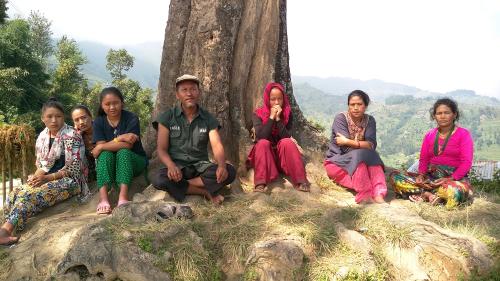
Martin Punaks shares with us a foreigner's perspective on the new crisis engulfing Nepal.
The country I live in is slowly slipping into another humanitarian crisis. It will be the second humanitarian crisis this year. But whilst the earthquake was an act of nature, this new crisis is very much man-made. The Terai – the plains area which runs along the Nepal-Indian border – has been shut-down for over two months, with schools and businesses forcibly closed and freedom of movement restricted as protestors bring normal life to a standstill. More than 45 people have been killed in violence between the Police and ethnic minority groups. Kathmandu is struggling to run with minimal petrol and gas, resulting in businesses closing, tourists cancelling, and the economy slowly collapsing. Perhaps saddest of all, the 2 million people affected by the earthquake in April – who were pledged $4.4 billion dollars by the international community to help them rebuild safe homes – are yet to receive a single rupee of this support from the Government (which manages the funds) because of internal Government arguments about who should be in charge of the agency responsible for managing the money. Meanwhile, the cold winter is drawing in and the survivors need to build new houses to stay warm and safe. If they go ahead and do this independently they will no longer be eligible for any compensation from the Government, and their houses will most likely be as dangerous as they were before the earthquake. Other support for earthquake-affected communities – such as health, livelihoods and child protection – is also grinding to a halt as NGOs can longer get to the affected areas because of petrol shortages. And all this suffering is related to an event which should have been good news – the promulgating of Nepal’s long-awaited constitution, which took seven years to write, and was meant to be the peaceful outcome of the bloody 10-year civil war between 1996 and 2006 – but instead looks likely to be the historical marking point for a new era in Nepal’s history of violence and discrimination. How did it all go so horribly wrong?
The violence started on the Terai before the constitution was promulgated because the ethnic minority Madheshis and Tharus living there – which make up approximately 40% of Nepal’s population – believed they would be under-represented in Parliament within the terms of the new constitution. They were right of course; they would have been representationally discriminated against, along with many other minority groups, not to mention women who would be deprived of the right to confer citizenship to their children. Many people believed it was a disappointing constitution – me included – but in fairness to Nepal and to democracy, it was legally voted through by an overwhelming majority of democratically elected representatives. So democracy won, whilst the weaker members of Nepali society lost, and this resulted in even more intense protests on the Terai by the Madheshis. This was the point when it all got complicated – because India decided to get involved.
The Madheshis are a group of people who are of ethnic Indian origin and still maintain close familial and cultural ties to India. India was already unhappy that Nepal had snubbed its efforts to influence the constitution making process in a way which would be favourable to India’s preferences, so ‘big brother’ India was all too willing to show its displeasure at ‘little brother’ Nepal. To punish Nepal, India instigated an ‘unofficial’ blockade of all of its Nepali borders to prevent petrol and gas getting into the country, and conveniently blamed this on the violence of the Madheshi protestors over the border by claiming it was too dangerous for India to send its truck drivers into Nepal. The fact that India had not had a problem sending drivers over the border during the month of violence leading up to the constitution, or that it still refused to send drivers over the border in areas where there were no protests, was never addressed. Nepal was left to accept that – be it official or unofficial – India had taken the almost medieval measure of cutting off a landlocked country’s resources in the hope of forcing it to change its mind on its internal affairs. Unfortunately, for Nepal, it was too late for negotiations: the constitution had been democratically signed and sealed. To change it now at India’s behest would effectively mean handing over sovereignty to a foreign nation, something no politician can do, even if he or she wanted to.
Both sides had managed to screw up in mammoth proportions by putting themselves in political positions where it was impossible to back down. To compromise now would mean ‘losing face’, and in South Asian culture, ‘saving face’ is more important than being right or wrong, even if it harms you in the process. So this is why we are in a political deadlock.
Instead of working with India to find a solution, Nepal has angered India even more by signing a new trade agreement with India’s biggest perceived competitor in Asia, i.e China (which may be symbolically important, but in practice will not bring much fuel into the country because of weak transport links over the Himalayas, and some believe it may even result in risks to Tibetan refugee communities sheltering in Nepal). Meanwhile, India has responded by officially reporting Nepal to the United Nations Human Rights Commission for its alleged role in extra-judicial killings, violence and ethnic discrimination. In fairness to India’s claims, it is a true fact that Nepal’s recently elected Prime Minister, KP Oli, beheaded eight people in his younger years as a communist leader; a crime for which he has never been tried. But in fairness to Nepal, KP Oli’s eight victims seem like a minor offense compared to the murders of over 1,000 people – mainly Muslims – by Hindu mobs in 2002 while Narendra Modi, the now Indian Prime Minister, was Chief Minister of Gujarat. It was a crime for which Narendra Modi stands accused of being complicit in so far as he did nothing to stop it happening despite being fully aware of it. So neither side really has the moral standing to accuse the other of human rights abuses.
Yet among all this political wrangling, arrogance and lack of strategic foresight, it is the Nepali people who suffer the most from our country’s worsening state of affairs. The vast majority of Nepalis – be they hill people or Terai dwellers – care not who threw the first stone. They just want the schools to be open for their children, they want their businesses to run, they want to drive their motorbikes to work, and they want gas so they can cook food and stay warm during the winter.
The earthquakes in April and May this year shook Nepal to the core. Nepalis were praised by the world for their resilience in the face of a disaster; for the way they rushed out to offer relief to their fellow country men and women, for the way they smiled and shook their heads and said “ke garne?” – meaning “what can you do?” – and got on with the job of trying to rebuild their lives and find humour in the face of adversity. Nepalis are well practiced in being resilient. They were resilient after a decade of civil war when 16,000 people were killed or disappeared. They were resilient when justice was never served to the perpetrators of the violence. They were resilient through countless ‘bandhs’ (shutdowns) when violent thugs burned tyres in the road and smashed the windows of any shop that dared to open. They were resilient as ‘load shedding’ (scheduled power cuts) crept up, hour by hour, until it became completely normal for the capital city to run on just 10 hours of electricity per day. And even now, they are being resilient through the violent protests on the Terai and the fuel crisis in Kathmandu. Ke garne? What can you do? It seems you can do nothing.
As a foreigner living in Nepal I have passed through a cycle which many foreigners living here have to go through. I began my days in Nepal in 2011 in a dreamy state of naïve joy at the friendly peaceful demeanour of the Nepali people; then as the realisation grew of how many things did not work properly, and how widespread the corruption was, this turned to frustration and anger; then over time I learned to accept Nepal the way it is – as Nepalis do – being grateful for each small gain I might be able to contribute to. I learned also to accept my position as an outsider for whom it is not always appropriate to comment on the internal affairs of a smaller, less-powerful country (a principle which is hard to put into practice of course when you are a human rights activist who likes to speak out when you see injustice being done!).
Yet with this latest humanitarian crisis I am confused as to what to think anymore. I struggle to make sense of the situation we find ourselves in. Verifying information to be factually accurate is challenging and it is hard to find true heroes or pure villains among the carnage of bad governance. Instead I laugh at the incredulity that an elected politician who, less than one year ago threw tables and chairs around the Parliament building, has now been promoted to Minister of Irrigation as a reward for his outburst of violence. I laugh at the un-believability that the Government is actually more concerned with appointing new Ministers than trying to solve the crisis engulfing the country. I laugh because it is the only way I can hide the incredible sadness I actually feel for this tragic country – seeing the huge amounts of potential it has in terms of the skills of its citizens and natural resources it could utilize, but instead manages to somehow waste most of it away.
However, what I cannot laugh at is the news of a bus falling off the side of a mountain road in Rasuwa and killing scores of innocent people because it was overloaded due to the fuel crisis. I cannot laugh at the endless lines of cars and motorcycles around the city waiting literally for days for a few measly litres of petrol. Nor can I laugh at the next generation of Nepali children growing up in a country without education, because the Government cannot get organised to rebuild the damaged school buildings, or because the protestors on the Terai have shut them all down.
Nepal is like a talented but tragic aspiring musician, loved by his followers for his music, and lamented for his drinking and drug-abuse. It is painful for his fans who care for him to see him destroy his potential, but they are powerless to stop him. Instead they praise him for his resilience to somehow keep performing his cherished songs, as the poison runs through his veins and his liver begins to fail. They admire him for achieving what he can, in his sick state, in the face of self-destructive adversity. Ke garne? What can you do? But then one day he stops performing all together. He dies and is buried. He becomes a legend of a once good man, who was taken before his time, and denied the opportunity to fulfil the greatness he could have been so capable of achieving.
I write this blog post not to criticise Nepal, but to express how sad I feel to see a country I have come to love fall to pieces before my eyes. Someone should do something! Nepalis should do something! But what can they do? Ke garne? Maybe there is nothing they can do, but be resilient, and carry on carrying on.










Add new comment